Caesars Palace


This palace of kings is based on the grandeur and augustness of Roman imperial empire. The word caesar means Roman emperor. There is a clan of them. The statue representing Caesars Palace is what's considered as the first emperor of Rome: Augustus Caesar (aka Gaius Octavius, Gaius Julius Caesar; 62 BC to AD 14).
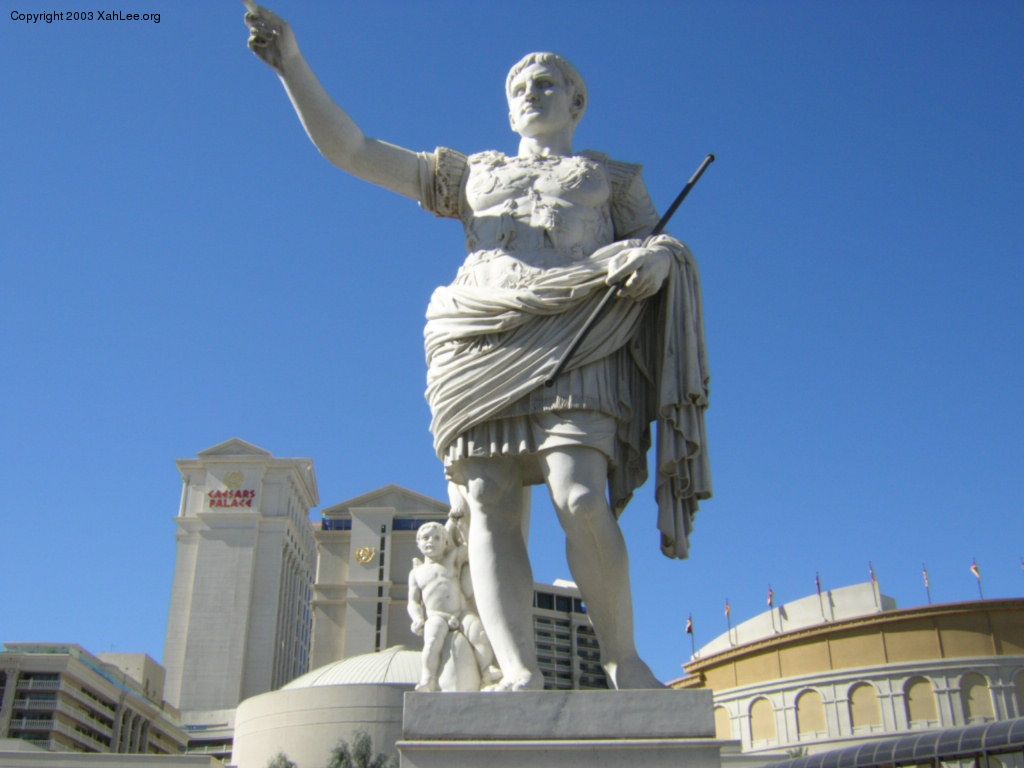
This statue is known as Augustus of Prima Porta, the most majestic depiction of Augustus. It is discovered in 1863 at Villa of Livia, Prima Porta, Italy. (which is a town nearby Rome). It dates to about AD 14, and is currently at Vatican Museums. At its feet is the love god Cupid sitting on a dolphin.
It is funny how a august propaganda-ridden imperialistic emperor has a cute love Catalyst with a dolphin tagging at its feet. In 21st century Americanistic cinematography, we can call it a comedy relief element for the militant aura. Or, politically or psychologically we say it is a element of appeasement or counterpoint to reinforce the benignity of a meanwhile forceful ruler by juxtaposition. We can say these things because sculptures are means of communication especially statues of rulers.

The entrance to the palace is lead by a elongated fountain headed by a headless goddess.



The plate at the bottom of this sculpture reads:
VICTORY AT SAMOTHRACE. GODDESS OF VICTORY. SCULPTOR UNKNOWN. ABOUT 300 BC. LOUVRE MUSEUM. PARIS, FRANCE.
American Heritage Dictionary tells us that:
Samothrace: 1. An island of northeast Greece in the northeast Aegean Sea off the coast of European Turkey. The famed Nike of Samothrace, now at the Louvre in Paris, was sculpted c. 200 B.C. and found on the island in 1863.
From encyclopedias we learned that she was the goddess of victory Nike, and was standing on the prow of a sculptured ship around 300 BC, built to celebrate a naval victory, and was found by a French archaeologist in 1863, and now sits inside France. The sculpture is one of the finest in history, a treasure of humanity.
Upon research of this goddess am bumped into this piece from Greece: http://www.esiemth.gr/BKT_EN/xxxxxxxx.htm ( local copy 200311return_nike.htm ),
purportedly by the “Editors Association of Macedonia-Thrace Daily Newspapers”, written in 2001, wailing of the looting and for the return of Nike Of Samothrace from France back to her rightful birthplace. The essay is eloquent. However, the human animals under natural conditions do not give to pleas but forces of physics. If the Greeks demand repatriation with sparkling cannons and ships, then the French certainly would give it a thought. Either by nature or by history, winners take all. Looting and pillage is a common play in records. As of recent, the most powerful nation in the 21th century the United States Of America in 2003 under George Walker Bush's lead is plundering and pillaging a weak nation Iraq. 〔see Photos of Iraq War〕
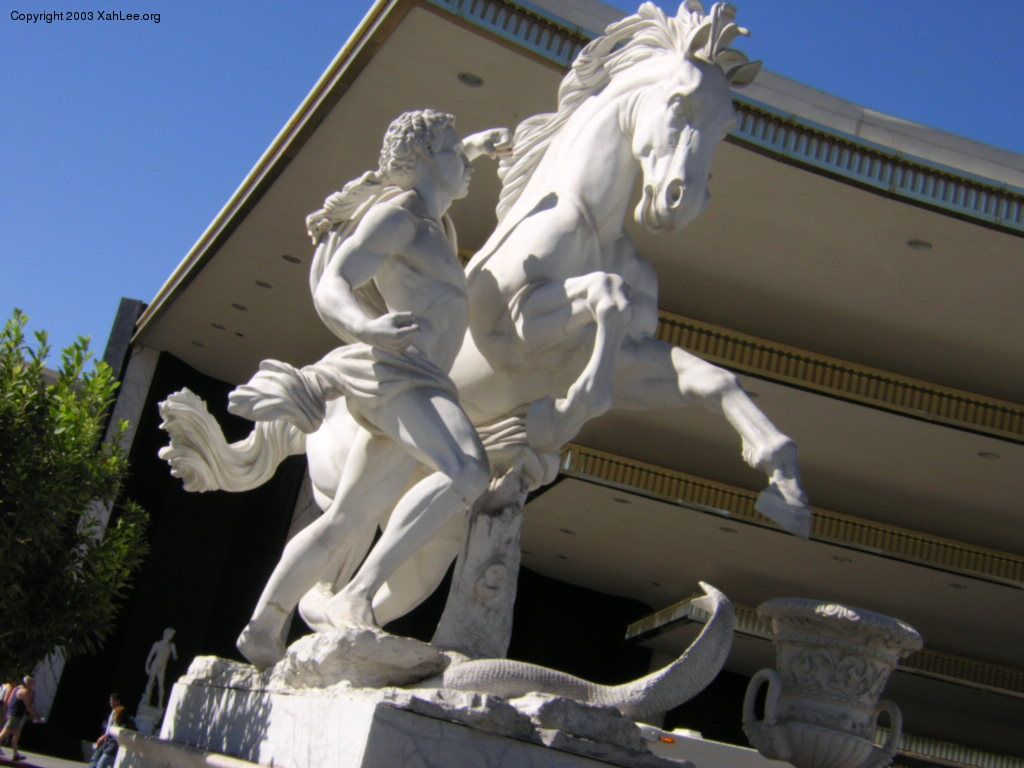
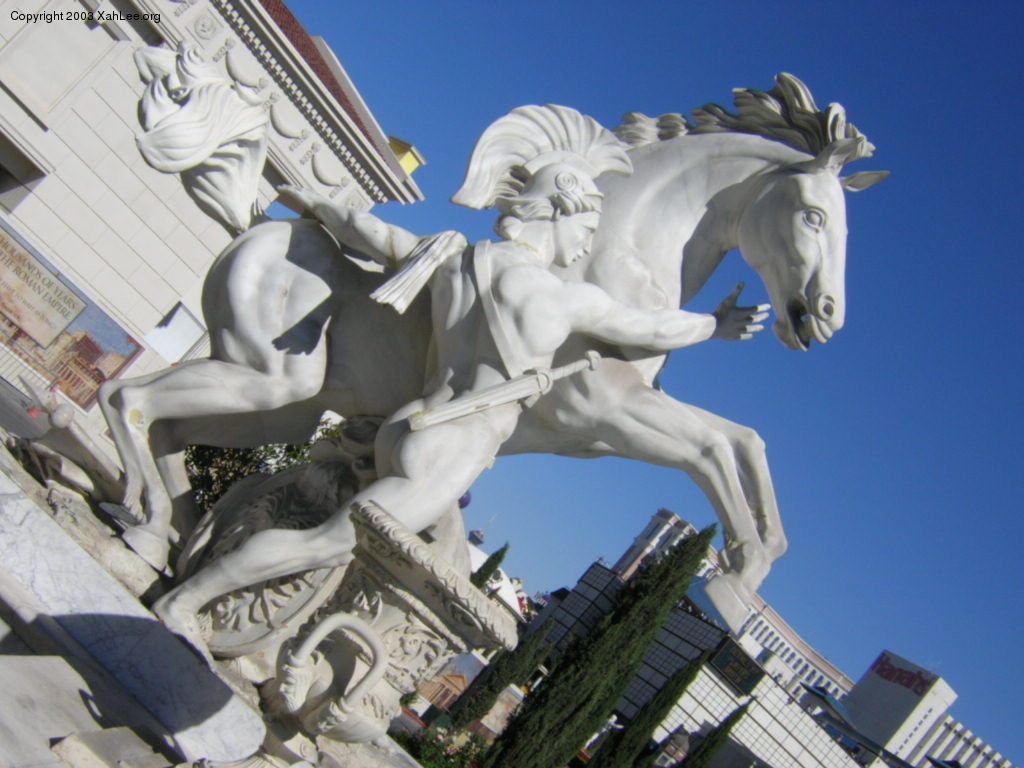
In front of the main door there is another rectangular fountain, containing three statues. The left and right ones both feature a horse and are without caption (please let me know if you do know their origin)
but the middle statue i found a plate that captions:
RAPE OF SABINES. SABINE WOMAN TAKEN BY A ROMAN WARRIOR.


Rape?!? My God! I was all agog to find raping glorified by a statue, even in Las Vegas. I do not realize the extend of my nascence until i looked it up. As it turns out, the Rape of the Sabin is a big thing. It is a occidental mythology subject to countless artistic realizations as cherished national treasures and artifacts of humanity.


The retelling of the legend Rape Of Sabines on the web varies quite a lot of bits, but the humanity of the legend goes thus: Romulus and Remus were twins thrown into a river to drown by their father's brother. They did not drown, and got reared by a she-wolf. Then they were found by a shepherd and raised as humans. After they grew up, they slew their uncle and founded Rome. Later on, Remulus slew Remus in a quarrel and became the sole ruler of Rome. Rogues are invited to grow the population but Rome lacked women. Remulus solved it by inviting the neighboring Sabine people to a festival, then took their wenches by force. The two people began for war. Then, the women (rapee) came forth and pleaded truce between their new husbands and their fathers and brothers, thus united Sabines and Romans, and the women became revered mothers of Rome.
The extremely beautiful Rape Of Sabines in front of Caesars Palace is a replica of Giambologna's (1529 to 1608) work of 1583. The original is in marble, 410 cm high, and currently at Loggia dei Lanzi, Florence, Italy. Excerpt from web sources:
The Rape of the Sabines marked the climax of Giambologna's career as an official Medici sculptor. This great marble was unveiled in the Loggia dei Lanzi in January 1583 in place of Donatello's Judith. The group is indebted to Giambologna's study of Hellenistic sculpture, particularly in the voids which penetrate the three interlocked figures. On a technical level it represents the fulfillment of an aspiration from antiquity. Ancient sources record sculptures made from a single block, a claim which the Renaissance discovered was not true. Giambologna intended to surpass antiquity by sculpting a large group from a single block that also involved a complicated lift. The result is the first sculpture with no principal viewpoints, it forms a spiral that is the culmination of the “figura serpentina”.
for the full story of The Rape of the Sabine Women, see Art: The Rape of the Sabine Women.
There are 3 sculptures on each side of the hotel's main entrance's door.
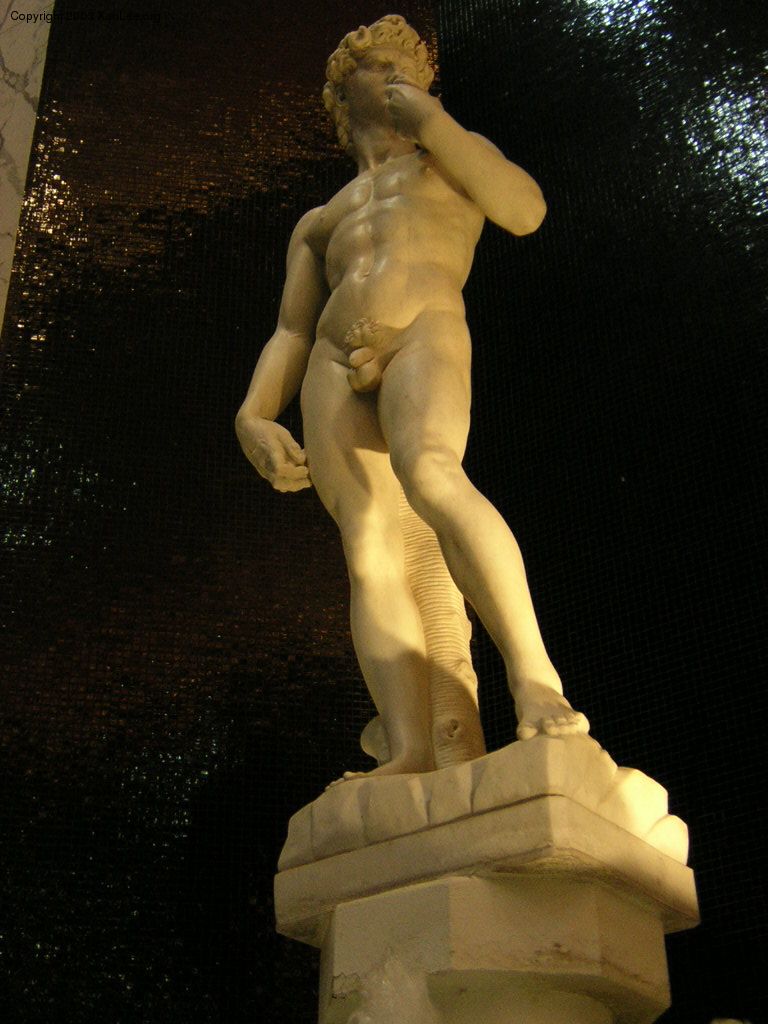
This is a replica of the infamous Michelangelo's David. I don't find this sculpture of David exciting in anyway. This David is by the Italian artist Michelangelo (1475 to 1564), carved between 1501 and 1504. It is 5.7 m high, in stone. Huge. Supposedly, the finesse of this sculpture lies in its depiction of the moment before David's fight with Goliath, displaying the calmness and potency of latent power. A interesting factoid is that this sculpture is not true to proportion. The head and torso are disproportionally larger, possibly because the sculpture was originally designed to stand on some high places in a church, so that it would look right from blow because of perspectivity.
David is a hero in the Christian sect's scripture. According to it, a giant Goliath of Gath, as a representative of the Philistines, challenged the Israelites to send a champion against him so that the issue of the war between the two tribes might be settled by a single combat. Goliath was killed in the resulting contest, in a rather unsportsmanlike way, by a stone shot from the sling of David, the youthful champion of the Israelites who later became their king. (Philistines are ancient people circa 1100 BC around today's Israel. Israelites are Hebrew or people of ancient kingdom of Israel. (Middle East history is quite complicated. I've read that they've been fighting since the beginning of time.))
There are several sculptures of Venus adorning the entrance of Caesars Palace. Venus is the goddess of sex and physical beauty of Roman mythology. She is the mother of Aeneas and Cupid. The mythology of Venus is much borrowed from the Greek goddess Aphrodite.
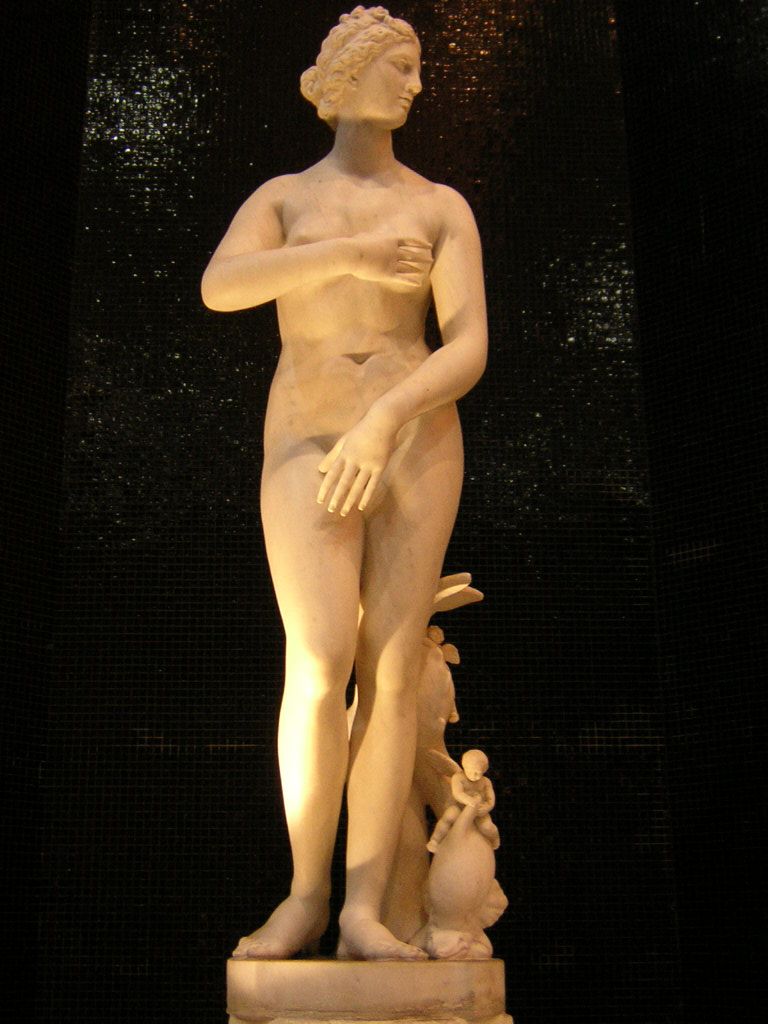
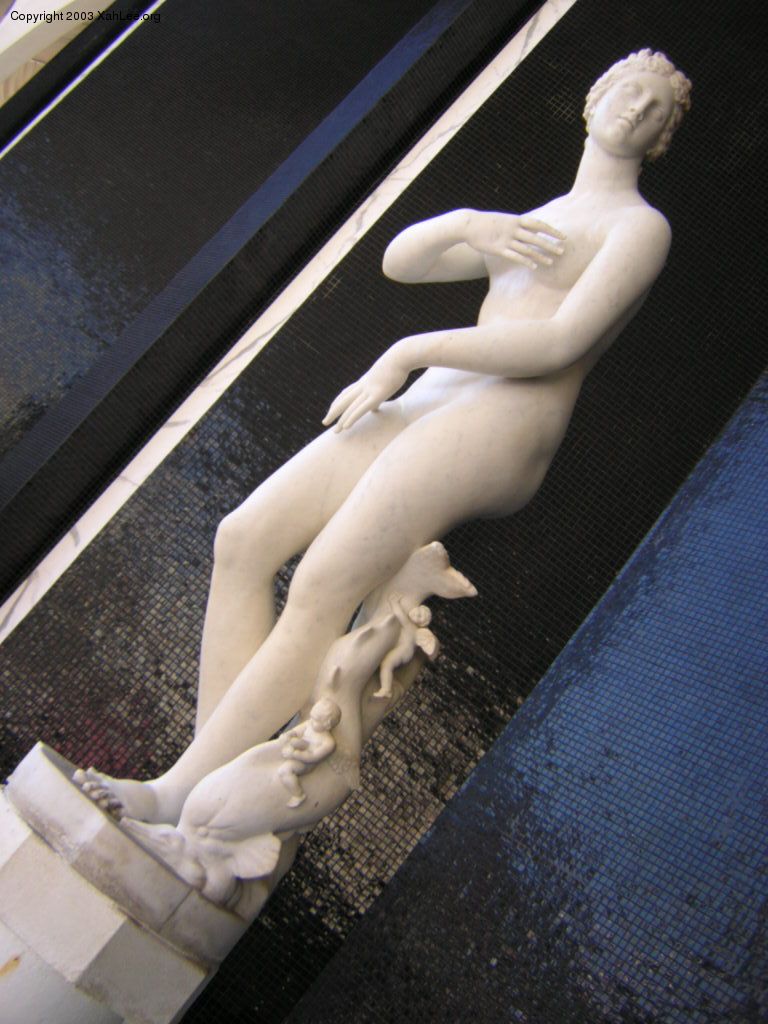
Looks shy to me. I don't think a representative of sexual love and physical beauty would have such gestures. Possibly coquetry, but rather ungainly, and i want my goddesses to have long hairs. At her feet is her son Cupid and another winged child (called Amoretti) riding a dolphin. Very cute. I wanna hug them and kiss them.


Hebe is the goddess of youth and spring, daughter of Zeus and Hera, and cup-bearer to the gods on Mount Olympus, serving them their nectar and ambrosia that keeps them youthful. She married the great Heracles (Hercules) when he is deified after his mortal death.

This famous sculpture is found in 1820 at Greek island of Melos. It is a marble sculpture, dates to around 130 BC, 203 cm high, and its creator is Agesandros, from Antioch on the Meander. The arms are missing, but one may be upholding a apple and the other drooped holding her garment. It is purchased by France and currently sits at Louvre Museum of Paris.
As you can see, the world renowned statues Aphrodite Of Melos and Nike Of Samothrace so happens are armless. The fact of their armlessness must have contributed to the esteem of their beauty and popularity. This is because, the threat and hostility of human animals mostly came from their arms. Thus, the suppression or open display of arms is often a expression of friendliness. We can see this in for example the arms-up posture of surrender, or the arms up in worship, or the traditional praying-like greeting gestures of Asia, or the sexual attractiveness when a female presses her open-palms against the wall as rendering it visible and difficult for hostile movements. We can also see it in the language, where “arm(s)” also means weaponry or readiness of attacking with weapons. A armless woman, has immense subliminal sexual connotations. In fact, fantasies of amputated women is a mainstay in at least modern SM (sadomasochism) subculture. 〔see The Glorification of Female with Limblessness (2004)〕

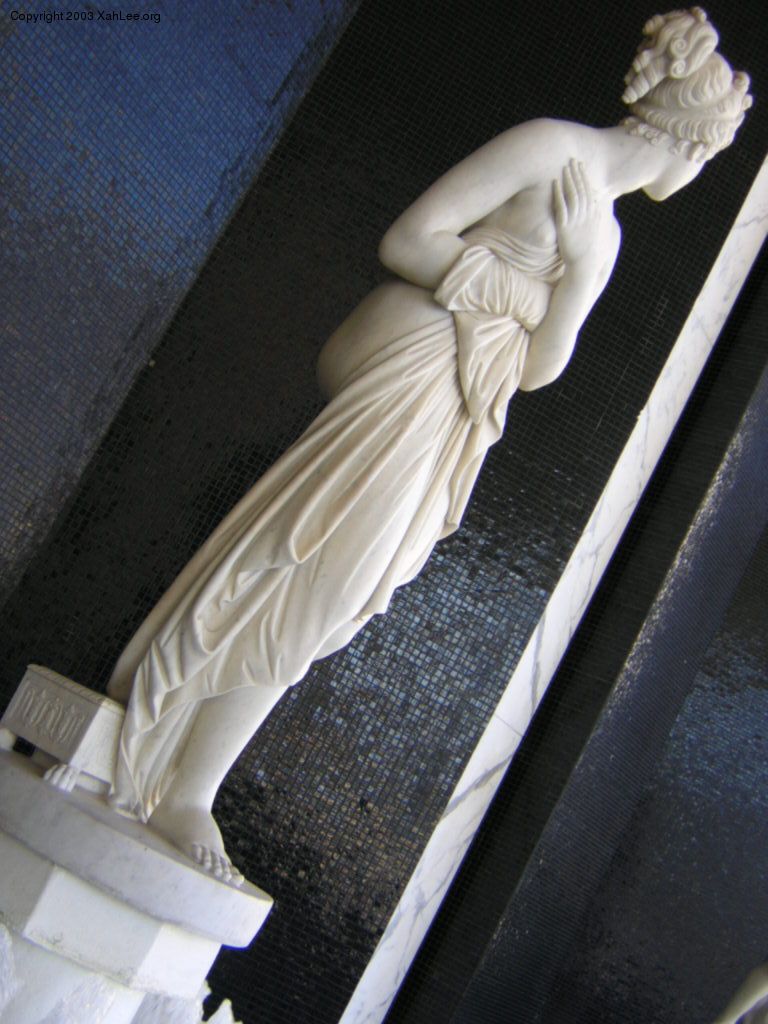
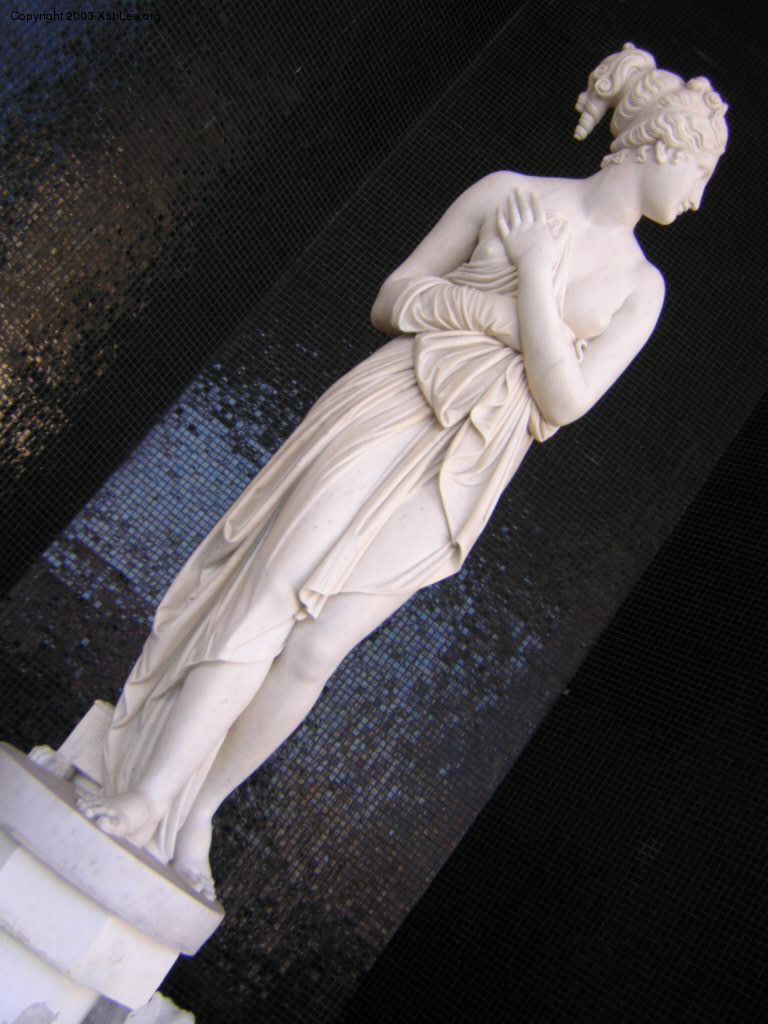
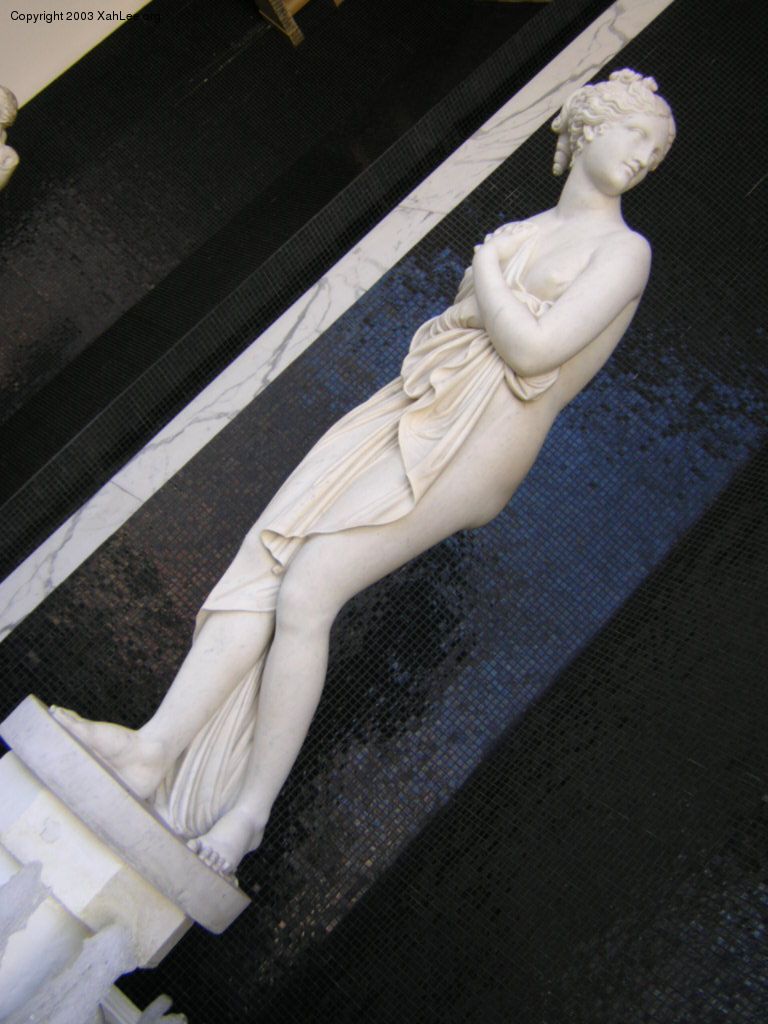
This sculpture is also known as Venus Italica. It is in marble by Italian sculptor Antonio Canova (1757 to 1822) during 1804 to 1812. This is hailed as his masterpiece. He created it to replace the ancient Roman statue Venus De Medici that a French emperor has seized from Uffizi Gallery in Florence in 1802. (Venus De Medici is shown above, the one with Cupid and dolphin at her side.).
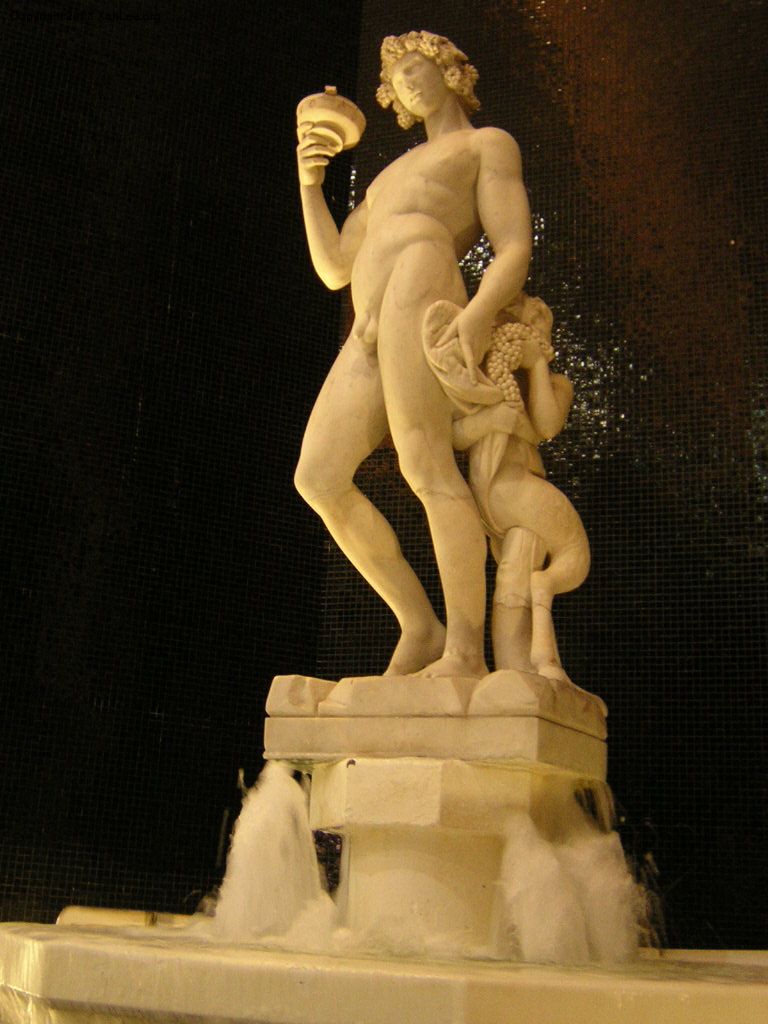

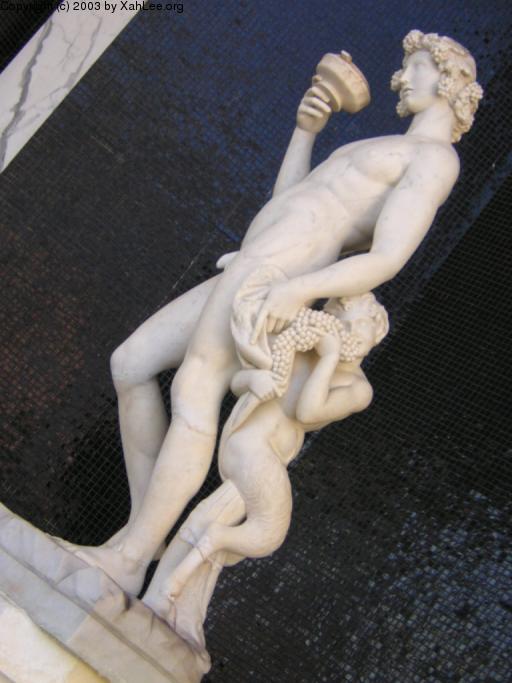
Bacchus is Roman's name for the Greek god Dionysus, a god of wine and vegetation, from which we have words like bacchanalia and orgy. The creature besides Bacchus is a satyr or faun, whose lower body is that of a goat. Satyr lives in the woods, and often follows Dionysus, making merry and chasing nymphs. They are the male counter-part of nymphs.
This is a admirable sculpture. The body is naturally robust. The posture warm and inviting. Much better than the sissy-looking and disproportional and heroic David. Note that Michelangelo has made Dionysus's balls asymmetric.
You will note that behind all these four sculptures are shiny black tilings. They are shiny because they are coated by a live flowing water, glistening along with time.
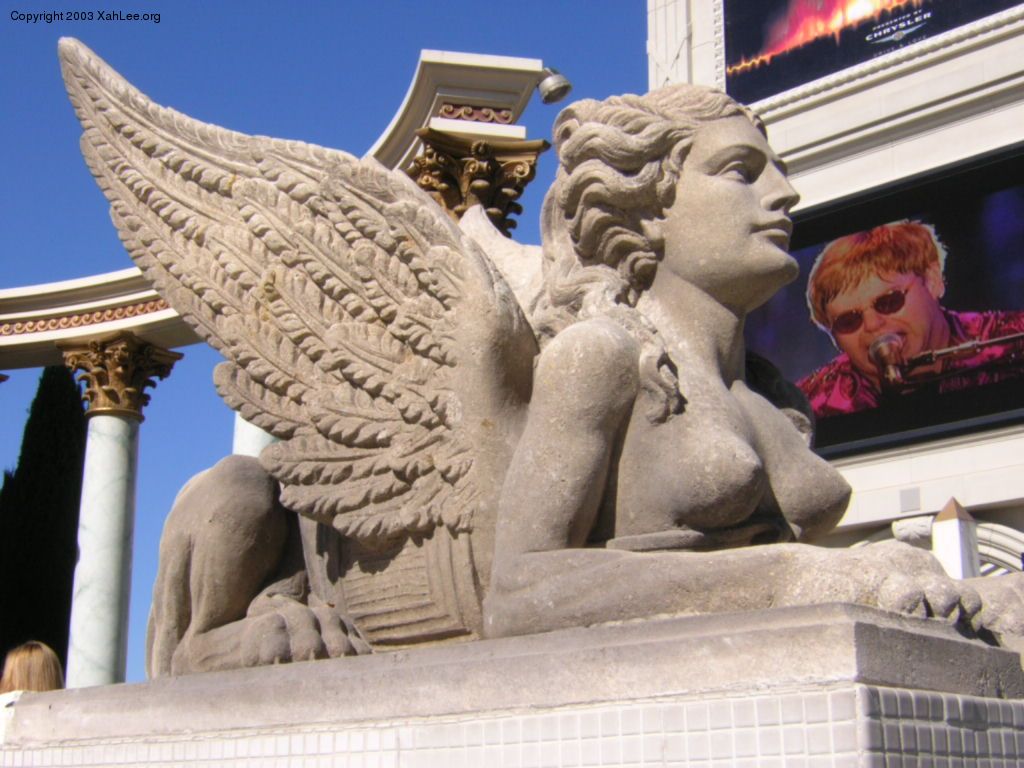
At a second entrance to Caesars Palace, a smiling sphinx is featured with prominent display of her ripe teats, and two golden girls on a cascading fountain.

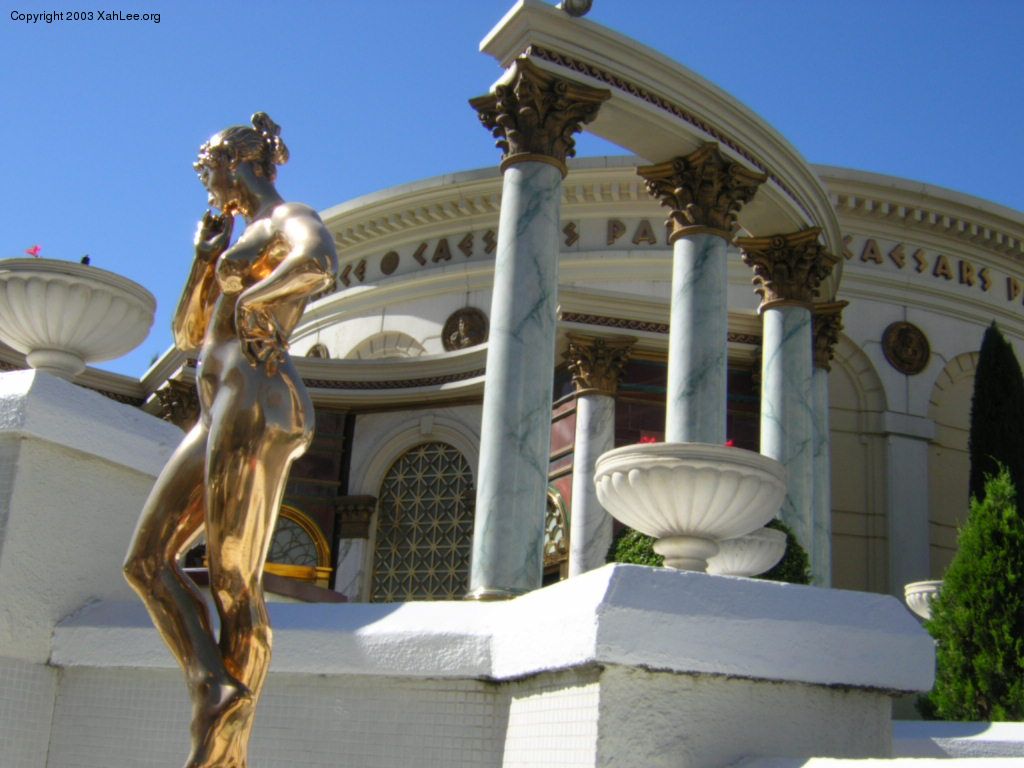
The (Greek) sphinx is a winged creature with lion's body and woman's head. It strangled all who could not answer her riddle, but killed itself when Oedipus answered correctly.
The Oedipus is another fascinating Greek fella. He is the son of Laius and Jocasta. He was abandoned at birth and unwittingly killed his father and then married his mother. (See also: A Love of Mythology of the Greeks.)
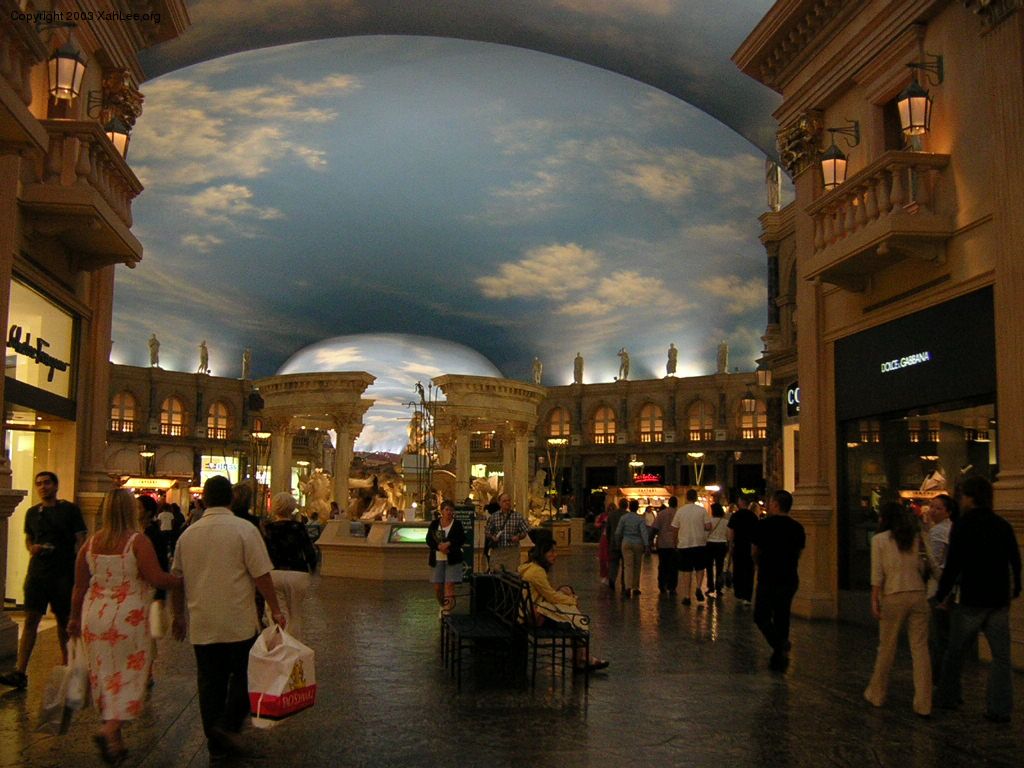

Inside Caesars Palace is a mall, decorated with lots of more pantheistic statues. The second photo must be Artemis, a virgin goddess of hunting and moon, twin sister of Apollo, daughter of Zeus and Leto, and is one of the dieties sitting atop Mount Olympus. Artemis is called Diana by the Romans. Despite her virginal beauty, Artemis is no cuddling babe. Her tales vary a lot and sometimes contradictory, but among things, one hapless hunter Actaeon who bumped into her nakedness while she's bathing, and stared, for that she made him into a stag and was rend by his own hounds, to Artemis's commanding satisfaction. And, she also shot her companion nymph maiden Callisto to death when Callisto unwillingly lost her virginity thru rape by Zeus (Artemis's dad) who disguised himself as Artemis. She also is said to be the cause of women who die at childbirth, some account as giving a swift painless death with her arrow. Her perpetual virginity is granted by her dad the omnipotent Zeus, at age of 3. Artemis is also the killer of Orion (the giant and hunter and son of the sea god Poseidon), who became a constellation. This virgin goddess also locked horns with Agamemnon, king of Mycenae and commander of Greek forces in the Trojan War. She stopped the wind in their voyage to Troy, which resulted the sacrifice of Agamemnon's own daughter Iphigenia. Artemis and her twin brother Apollo, together killed like a game the 6 daughters and 6 sons of the queen Niobe (daughter of Tantalus, queen of Thebes, wife of King Amphion (son of Zeus)), only because Niobe boasted her superiority over Leto (Arthemis's mother) for she had 12 offspring versus Leto's only two. (Niobe ended up becoming a stone perpetually wet with her tears.).
Artemis is one Western bitch. The moral of Artemis tells us that, male human animals want to make believe that beautiful women are dangerous and hard to get. (and, this is not untrue from a modern economics point of view. The more value a thing, the higher is its price tag, by virtue of natural competition, generally speaking. Free lunch comes only as a anomaly.). The psyche of male human animals is understandable. In the lingoes of the guild of modern sociologists, Alpha Male is the epithet assigned to male that has dominance in a group, who also gets most of the chicks. For the rest of the males, sour grapes syndrome is but the most comforting thought.
The Greeks is the foundation of much of the occidental culture. Them and their mythologies; powerful creatures and beautiful goddesses, eternally revolves around materialistic thoughts and sexuality of orderless variegation and heterogeneity. (and later on, a hypocritical and intolerant Christianity vie for dominance.).

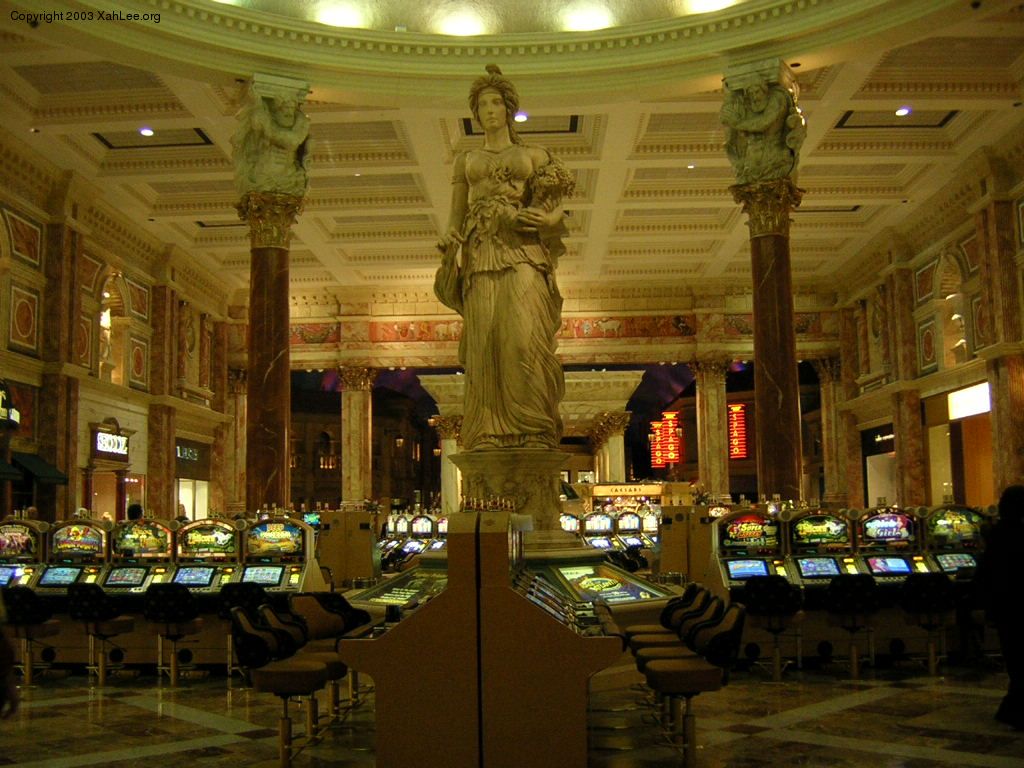

Who is this majesty, standing atop arrays of slot machines? Research assured that she is the Greek Tyche or Roman Fortuna, goddess of fortune and chance, and also prosperity. Holding her signature cornucopia.
There are lots of other deities inside the palace that i was too timid to take photos among tourists, in fear of them focusing their attention upon this odd loner sneaking around with a camera taking interests in inanimate objects no average mortals would.
